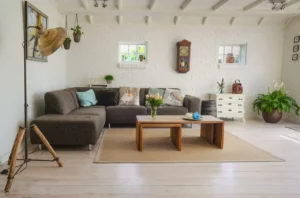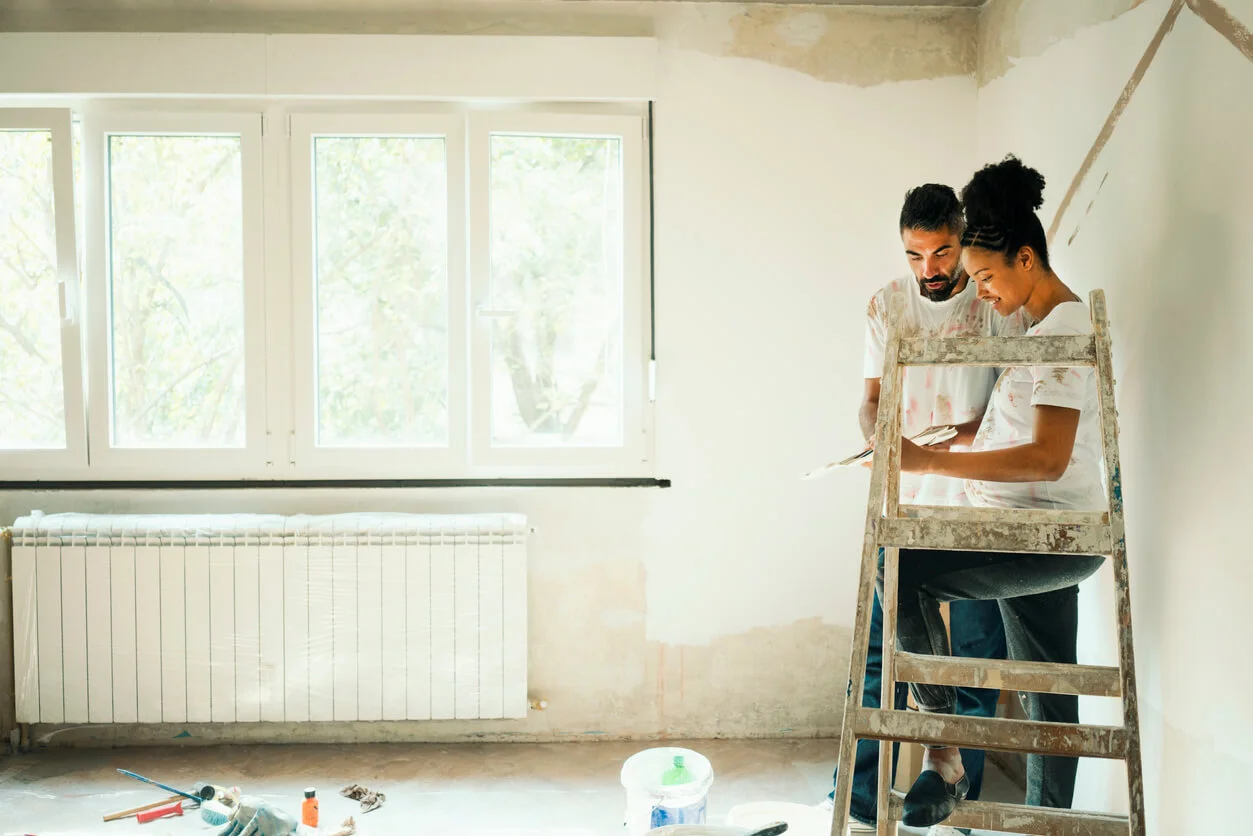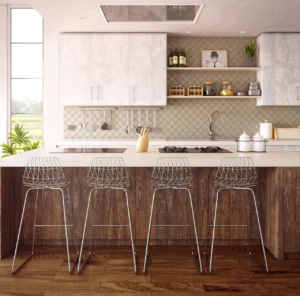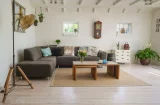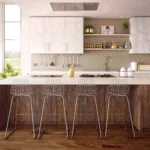Serenity Now – The Quiet Beauty of Minimalism

“Have nothing in your homes that you do not know to be useful or believe to be beautiful”. – William Morris
Minimalism has been treated unfairly. It is often misunderstood and misrepresented as the cold, sterile “cousin” of modern design. While it is true that modern design’s focus on natural materials, neutral colors, and elimination of unnecessary detail provides its foundation, minimalism is so much more than that.
Perhaps the blame should be placed on the name itself, for it invokes the thought of living without. And it is true; those who employ the minimalist style follow the axiom “less is more”. But choosing to design a home with “less”, also means less stress, less chaos, and less clutter. What exactly is minimalism? What are the benefits? And how can you incorporate it into every room?
Minimalism
Conceptualized during the 1960’s by a group of artists including Donald Judd and Dan Flavin, minimalism grew out of an interest in geometric abstraction. Their art focused on geometric shapes and forms, which naturally grew into a trend towards simple, clean lines. A design style that focuses on form and function, minimalism is all about simplicity. It is characterized by clean lines, a mono-chromatic color palette, and uncluttered surfaces. Furniture is made from quality materials and is comfortable and inviting. This style “usually combines an open floor plan, lots of light, and functional furniture”.
Minimalism is a very cerebral style of decorating; it does not occur without thought, planning, and purposeful purchases. There are no impulsive shopping sprees culminating in additional tchotchkes; nothing in minimalist design is frivolous. In fact, perhaps a more concise axiom for this design style is “everything needs a place and a reason”. With this very thoughtful approach to design, minimalism “creates a haven for living”. A home decorated with minimalism in mind feels as good as it looks; “simplicity is an amazing feeling to come home to”.
The Benefits
Choosing a “less is more” approach to design has many benefits:
- A clutter-free space, the hallmark of minimalism, creates a very calming and serene environment. Without the visual stimuli associated with clutter, a home’s design can be restful, rather than stimulating. With an emphasis on function, form, and practicality, a sense of freedom and relaxation abounds.
- This desire for clean and clear surfaces, encourages a mindfulness towards clutter. Incorporating daily habits that prevent clutter from accumulating, results in a less stressful, more efficient way of life.
- Streamlining a home’s furniture and décor gives you more room; even small spaces appear larger.
- Although usually associated with modern and contemporary homes, minimalism is extremely adaptable. Any style of home can embrace its sense of simplified beauty. Paring a room down to its essentials, incorporating a soothing color palette, and surrounding yourself with uncluttered surfaces, “creates a healthy, less chaotic and aesthetically-pleasing home”.
- Each piece of furniture and décor is carefully curated, with style, form, and function in mind. Purchasing high-quality items, made from superior materials, will ensure they stand the test of time.
- Although these purchases are deliberate, they are not plentiful. “Less of everything means less money spent”.
- As simplicity is the key to the minimalist style, individual furnishings can be easily mixed and matched.
- Choosing to include only the essentials, leaves room for sudden bursts of personality. Unique design details, such as atypically- shaped tables, mirrors, or pendant lights, can lend an air of sophisticated simplicity.
- Keeping the space simple and uncluttered, allows you to highlight any architectural features that might otherwise become lost.
The Minimalist Design Room by Room:
Minimalism is based on a specific aesthetic: clean lines, high-quality functional furniture, a monochromatic color palette, and uncluttered, clean surfaces. It always begins with a decluttering session to rid the space of any superfluous items not deemed to have a function. Once this foundation has been established, minimalism can be incorporated into every room within a home.
In the Kitchen:
- Storage is the key to uncluttered surfaces. Create organizational solutions to ensure every item has a home.
- Choose simple, high-quality cabinetry and hardware, finished in a neutral color such as white, cream, or grey.
- Keep window coverings either non-existent or sheer. Another characteristic of minimalism is lots of natural light; keep the windows unadorned whenever possible.
- Countertops and flooring should stay within the monochromatic color palette; “stick to a trio of hues per room that are just a few shades apart from each other for a smooth consistency”.
- Wooden tables and chairs can add warmth and dimension and will prevent the space from becoming too stark.
In the Living Room:
- Walls should be painted in a color that promotes a sense a calm; white, off-white, cream, or light grey such as Benjamin Moore’s® Grey Owl, will create a perfect base for the monochromatic color palette.
- Add functional accessories within the same color palette; “stick to a core range of complementary hues and bring in the unexpected” for added interest. Faux-fur rugs and tone-on-tone textured throws and pillows will create subtle bursts of warmth and interest.
- Minimalism is about creating soothing and serene environments. Surfaces should be uncluttered and free from excess décor. Coffee table vignettes have no place in a minimalist design unless the items serve a function. For instance, a beautiful bowl can be placed on an ottoman or table, to house the television remote.
- Choose functional but comfortable furniture in a solid, neutral color. Typically, sofas are elegant and not over-designed.
- The focus should be on simplicity; include furnishings with “flat, smooth surfaces and strong, clean lines”.
- Embrace blank space; leave the wall above the couch empty, rather than filling it with art that brings no joy.
- When so many functional pieces are noticeably unique in shape, the walls can be unadorned to rest the eye, making the ceiling seem higher, and the room overall seem more peaceful.
- To avoid the risk of the space appearing “cold”, add warmth and energy with plants. Keep in mind, they should be placed strategically throughout the room to appear curated rather than cluttered.
- Simple window coverings within the color palette can be hung for a clean, uncluttered look.
- Functional but decorative lighting will also add personality to the living room.
- Pops of color can be incorporated in small accent pieces such as artwork or a curated bookshelf. Decorate with small collections in the same monochromatic color palette. The display will not appear cluttered as the items will be read “as a group as opposed to individual things”.
In the Dining Room:
- A calm, elegant dining room can provide a quiet yet beautiful addition to an open floor plan.
- Choose wall color and window coverings with the same intention as in the living room.
- Add tables, chairs and perhaps a buffet with classically simple, clean lines. Individual pieces must work together in their basic shape; incongruity will create a disjointed and stress-inducing environment.
- Ensure surfaces are uncluttered and ample storage exists for the dishes, tableware, and linens.
In the Bedroom:
- Bedrooms benefit from a minimalist design; a calm, serene environment can create the foundation for a restful, night’s sleep.
- Choose a wall and floor color in a neutral, soothing palette.
- Add luxurious bedding, accent pillows and throws within the same range of monochromatic hues. The tone-on-tone layers will add depth, warmth, and personality. Soft accents will make a simple room feel inviting and homey without cluttering it up visually.
- The addition of functional furnishings with clean, simple lines will ensure every personal item has a minimalistic home.
- The hard surfaces of the furniture and the soft details of the bedding will create symmetry and balance.
- Every bedroom requires task and ambient lighting; ensure the selection is both functional and decorative.
In the Bathroom:
- Smart storage solutions are crucial for ensuring the bathroom surfaces are clean and uncluttered.
- All bathroom features including tub, shower, sink and vanity, should showcase clean lines and no unnecessary embellishments.
- Choose wall and floor color with intention. Staying within the monochromatic color palette will create a consistent aesthetic.
Although it takes thought and effort to create a space with a minimalist design, it’s impossible to deny the serenity and simple beauty when confronted with a resolved minimalist interior. Paring down a home’s furnishings to include only the essentials, ensures a space unencumbered with excess visual stimuli.
Calming, consistent color palettes, clear and uncluttered surfaces, and beautiful, carefully curated furniture, all combine to create a soothing home. With a focus on function and practicality, every item placed within a room must have a reason for its inclusion.
This cerebral approach to decorating may sometimes be misrepresented, but it is by no means a cold relative of any design style.

Learn About our Decorating & ReDesign Certification






